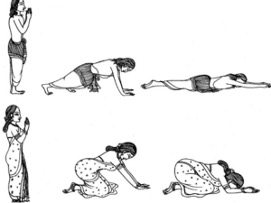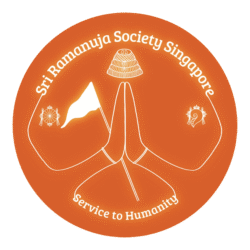By Smt. Sarvatha Varadharajan
Every act in Sanatana Dharma is intentional, from the way we offer prayers to the way we bow in reverence. One such act is the namaskaram, or prostration. Though often seen as a simple spiritual gesture, recent neuroscience reveals how remarkable these movements truly are. Modern studies suggest that using the non-dominant side of our body, engaging in symmetrical movements, and practising focused gestures can enhance neuroplasticity, which is the brain’s ability to grow and adapt. In this article, we will explore how an age-old practice like the sashtanga namaskaram can quietly nurture both body and brain.

What is neuroplasticity?
As mentioned above, neuroplasticity is the brain’s ability to grow and adapt. Meaning, it is the brain’s remarkable ability to reorganise itself by forming new neural connections throughout life. The brain constantly forms new connections, reorganises itself, and even recovers from injuries. It rewires based on what we do, think, and experience. The more we challenge the brain with new or mindful tasks, especially ones that involve movement and focus, the more we encourage it to stay active, resilient, and sharp.
What does modern science say about this?
Recent neuroscience research has shown that something as simple as performing everyday mundane tasks with the non-dominant hand has improved a very important part of the brain, the grey matter. Forming only 40% of the brain, it is very important for information processing. It helps us form thoughts, build memories and emotions, and helps us move around. So, we have to do as much as we can to nourish it.
In a 2013 study, patients with damage to the cerebellum (the part of the brain involved in balance and coordination) showed an increase in grey matter after doing repetitive balance exercises for just two weeks! This shows that even damaged brains can adapt structurally through targeted physical movements. Practices involving intention, repetitive posture and balance, such as the sashtanga namaskaram, could potentially enhance or preserve brain function.
The neurospirituality of namaskaram
Many of the practices in Sanatana Dharma often carry hidden neurological benefits. They involve intentional movement, symmetry, and repetition, all of which stimulate the brain.
The sashtanga namaskaram refers to full-body prostration, and it is commonly performed during satsangs, spiritual gatherings or even in front of the deities. This is also known as shad anga, meaning 6 parts of the body, where it involves two hands, two legs, the forehead and the chest to touch the ground in a coordinated, conscious manner. What makes this unique is not just the physical movement, but the awareness and humility behind it.
When we do namaskaram, we often unintentionally lead with our non-dominant side of the body to balance ourselves. This helps us activate both sides of the brain and encourages them to work together more smoothly. This type of movement is called cross-lateral movement, where the opposite sides of the body, like your right hand and left leg, move together. This is the same kind of movement we use when we crawl as babies or walk naturally. But the sashtanga namaskaram goes further; we lower our entire body to the ground and rise back up, slowly and mindfully, often while chanting or offering a prayer. This engagement of gravity adds another layer of physical and neurological effort.
It is worth noting that the way sashtanga namaskaram is done can vary based on tradition and gender. Traditionally, men perform the namaskaram with legs extended fully, bringing the entire body flat to the ground. Women, on the other hand, often bend their knees and sit back slightly during the movement, maintaining a posture of modesty and grace. This is known as the panchanga namaskaram. Nonetheless, both variations offer similar brain-body benefits.

PC: Vedicology India
Another interesting aspect is that the namaskaram is often done four times in a row. Spiritually, this repetition symbolises total surrender to the Divine. Neurologically, it helps reinforce the movement, improve posture, and strengthen the brain’s motor memory, much like training in sports or yoga. Each repetition offers a deeper connection, not just spiritually, but mentally. The act becomes more fluid, more aware, and more nourishing to the nervous system.
More than devotion
In essence, sashtanga namaskaram is a quiet, sacred blend of devotion, intention, and natural brain training. It connects our bodies to the earth, our minds to the Divine, and our hearts to a tradition that has always honoured wholeness, of movement, of meaning, and of being. So next time you bow in namaskaram, know that you’re not just practising humility, you are gently strengthening your brain, balancing your body, and walking in the wisdom of a culture that understood the mind-body connection long before modern science gave it a name.
Neuroscience studies on balance exercises and neuroplasticity
Structural brain plasticity in Parkinson’s disease induced by balance training – this study shows how balance-focused training helped increase grey matter in patients with Parkinson’s disease
Brain Changes Associated with Postural Training in Patients with Cerebellar Degeneration: A Voxel-Based Morphometry Study – this is the study mentioned in this article regarding an increase in grey matter in patients with damage to their cerebellum following balance-focused training
Systematic Balance Exercises Influence Cortical Activation and Serum BDNF Levels in Older Adults – this study shows how balance training in elderly folks can potentially reverse age-related damage to the brain and help with neuroplasticity

No responses yet